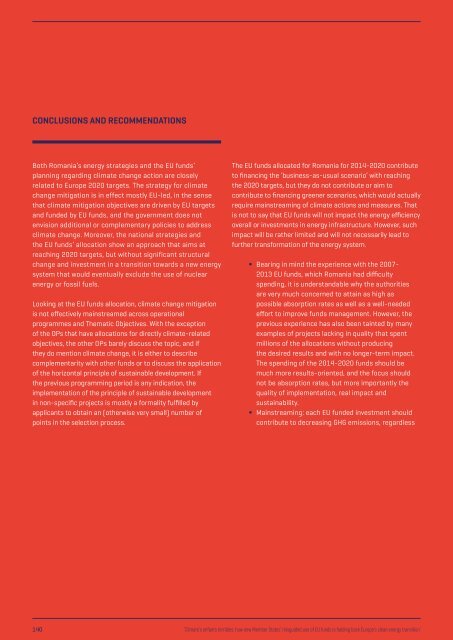ENFANTS TERRIBLES
enfants-terribles
enfants-terribles
You also want an ePaper? Increase the reach of your titles
YUMPU automatically turns print PDFs into web optimized ePapers that Google loves.
CONCLUSIONS AND RECOMMENDATIONS<br />
Both Romania’s energy strategies and the EU funds‘<br />
planning regarding climate change action are closely<br />
related to Europe 2020 targets. The strategy for climate<br />
change mitigation is in effect mostly EU-led, in the sense<br />
that climate mitigation objectives are driven by EU targets<br />
and funded by EU funds, and the government does not<br />
envision additional or complementary policies to address<br />
climate change. Moreover, the national strategies and<br />
the EU funds‘ allocation show an approach that aims at<br />
reaching 2020 targets, but without significant structural<br />
change and investment in a transition towards a new energy<br />
system that would eventually exclude the use of nuclear<br />
energy or fossil fuels.<br />
Looking at the EU funds allocation, climate change mitigation<br />
is not effectively mainstreamed across operational<br />
programmes and Thematic Objectives. With the exception<br />
of the OPs that have allocations for directly climate-related<br />
objectives, the other OPs barely discuss the topic, and if<br />
they do mention climate change, it is either to describe<br />
complementarity with other funds or to discuss the application<br />
of the horizontal principle of sustainable development. If<br />
the previous programming period is any indication, the<br />
implementation of the principle of sustainable development<br />
in non-specific projects is mostly a formality fulfilled by<br />
applicants to obtain an (otherwise very small) number of<br />
points in the selection process.<br />
The EU funds allocated for Romania for 2014-2020 contribute<br />
to financing the ‘business-as-usual scenario’ with reaching<br />
the 2020 targets, but they do not contribute or aim to<br />
contribute to financing greener scenarios, which would actually<br />
require mainstreaming of climate actions and measures. That<br />
is not to say that EU funds will not impact the energy efficiency<br />
overall or investments in energy infrastructure. However, such<br />
impact will be rather limited and will not necessarily lead to<br />
further transformation of the energy system.<br />
• Bearing in mind the experience with the 2007-<br />
2013 EU funds, which Romania had difficulty<br />
spending, it is understandable why the authorities<br />
are very much concerned to attain as high as<br />
possible absorption rates as well as a well-needed<br />
effort to improve funds management. However, the<br />
previous experience has also been tainted by many<br />
examples of projects lacking in quality that spent<br />
millions of the allocations without producing<br />
the desired results and with no longer-term impact.<br />
The spending of the 2014-2020 funds should be<br />
much more results-oriented, and the focus should<br />
not be absorption rates, but more importantly the<br />
quality of implementation, real impact and<br />
sustainability.<br />
• Mainstreaming: each EU funded investment should<br />
contribute to decreasing GHG emissions, regardless<br />
140<br />
‘Climate’s enfants terribles: how new Member States’ misguided use of EU funds is holding back Europe’s clean energy transition’


